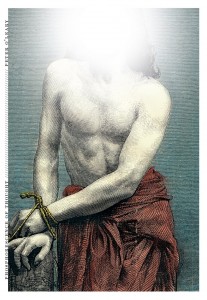Book Review
 The wren
The wren
the mind
allows
to sing
alights
—and flits—
So begins Peter O’Leary’s Phosphorescence of Thought, a book-length poem with section markers signaling seven movements, each with three sections, for twenty-one total, an arrangement resonant of Whitman’s “Song of Myself.” The book’s form is fluid, a central current buoys its pauses; the book unfurls, as if transcribing the ongoing cosmic song, a poetic tap into universal energy, recording, chanting along—interjecting—repeating and varying, making new stories of origin, moving on. The book sustains an unabashed rush of sound and grounding reference: “embouchure’s loveliest utterances: / myth. / Myth and song.” The book is a profuse production apropos of poesis that practices Ovid’s lushness and Whitman’s inclusivity. The book contains list, litany, anaphoric rant/chant, myth and fable, reiteration to leave a mark, mantra to break through walls of thought, observation of presence and absence, repetition associated with ritual, with prayer, with epic invocation and catalogue. And then—
The wren,
again.
Why a wren? Small passerine, of the Troglodytidae family, wren of complex song, of “remembered song,” wren as cultural keeper:
A house wren. Its beak a slightly silvered sickle, its remembered song
—rapidly rolling, a bubbling, liquid trill—
“Liquid trill” here invokes Whitman, one of the several voices funneled in the book, along with Dickinson, Blake, and other saints. Their songs are freely borrowed and folded into O’Leary’s, more than an echo, more of “thoughtful merge.” The following is one of the many passages containing Whitman’s language and subjects:
Uniform in loneliness
hieroglyphic in mystery…
…
the lull the air pulls from the last sweet urges to keep sleeping, only in the
morning’s all-holy mouth
I like
the lull light makes you wake with…
The poet flies on borrowed wings to journey over scenes tragic and ordinary, inhabiting, commenting, perhaps like the wren’s complex song.
The next chant opens with “Make holy,” resonant of Ginsberg’s “Howl,” and unfolds along anaphoric incantation—more than one hundred lines:
you angels of God and you heavens….you unbearable creative moment….you telescope of time, you notion of creation….and make holy
you fires, you heat, you winters, you hot summers….you environmental instability….you sweet fuckers….you passerines migrating through the leaves oxygenating the reek…you hydrodynamic, pluvious Des Plaines…you lifeforms
surging, metabolizing, expiring….
The question of why the wren, what is the wren, or any bird, is spoken to throughout the book: “At every hour we’ve ever imagined, a bird is on the / wing”; and “our first depictions / were animals—bulls, gazelles, cranes, souls”; and “Migrations’ astonishing parallels between image and idea, between / species and soul in communion with motion, in / commotion, its eucharistic transformations.” Of course, transformation—the myth filled with them, the avian form a favorite for its resonant flight. Philomel turned nightingale to escape silence and horror, drowned Ceyx and grieving Alcyone turned into sea birds to faithfully, monogamously mate. Bird as survivor, symbol, signal. Wren as “Little / latter-day survivor. Little memory-remnant of the forest world” and “Little signaler of the end of days.”
The setting for this book’s story is “The woods. The shabby little Forest Preserve. // The little house wren in it, his cinnamon supercilium,” and the speaker’s ecological concerns focus on the Des Plaines River. The story here also the “study of the mind / within.” What is the wren? As the poet offers in an end note, the wren serves as an embodiment of the epiphenomenal, of an overflow of consciousness, a form O’Leary gives to what Jesuit mystic Pierre de Teilhard de Chardin’s describes as “phosphorescence of thought.” O’Leary’s poem tracks the cycle of creation “not chronologically but intuitively, episodically.” Episode, stanza, chant, fable.
The wren of fable is the one who borrowed/burrowed the eagle’s strength to fly highest “and therefore to be king,” the wren “cleverer” for having hid itself in the eagle’s feathers, for having flown on borrowed wings, witnessing. O’Leary prompts us following the fable: “So what’s the wren? The mind’s feeling force— / the heavenly starlight that shines unwaning.” And what is transformation? Why invoke? O’Leary merges myth, the wren, consciousness—if we look, we find: “Somewhere, then, there is a transformation… / The question is, where—in the nerve world or in the mind world.” And what is the mind, its overflow, what form does consciousness take? Do we allow, will it, do we generate, do we create? Beginning again:
The wren
the mind
allows
to sing
alights
—and flits—
About the Reviewer
Jacqueline Lyons is the author of the poetry collection The Way They Say Yes Here (Hanging Loose Press, 2004) and the chapbook Lost Colony (Dancing Girl Press, 2009). She teaches creative writing at California Lutheran University.